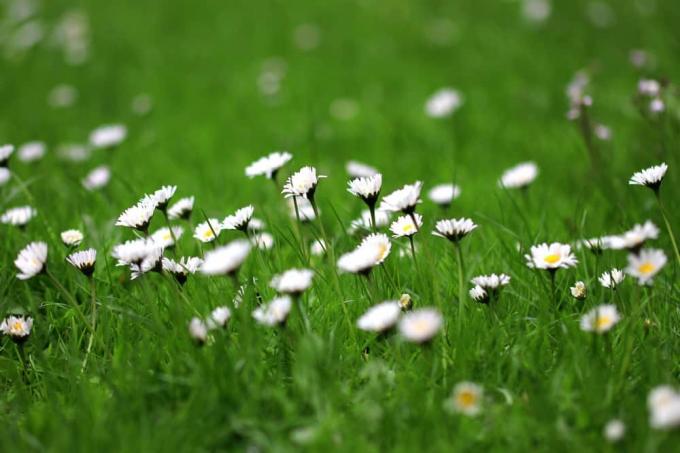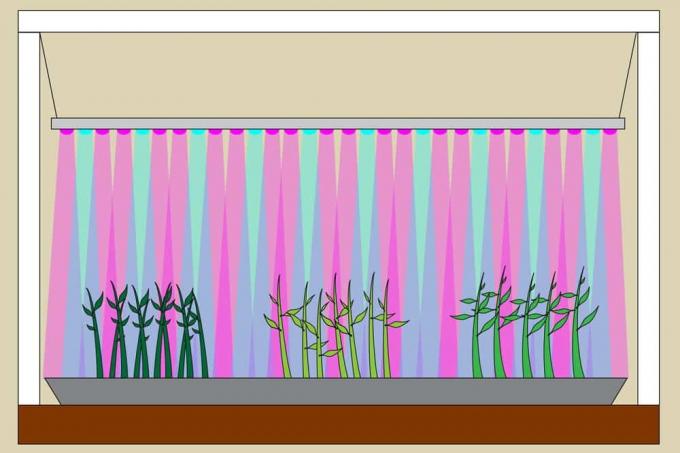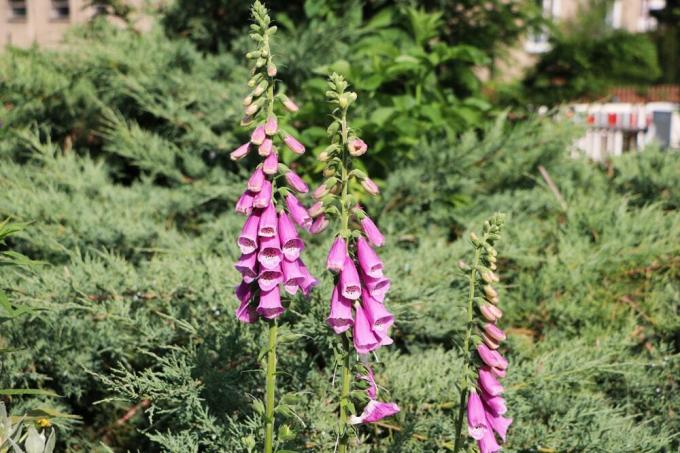

Table of contents
- plant selection
- Early flowering perennials for sunny, dry locations
- Summer flowering perennials for dry, full sun
- Late flowering perennials for sunny, sandy spots in the garden
- Succulent Plants
- Grasses for dry, sunny beds
- Sun-loving subshrubs
- Conclusion
Areas in the garden that are in full sun can not only get very hot in summer, they are usually extremely dry. If the soil is also quite sandy and can hardly store any water, the area seems at first glance to be completely unsuitable for plants. But a whole range of plants has also specialized in these extreme locations. Many plants only feel really good when they are exposed to at least six to seven hours of sunlight and can also cope well with prolonged drought. Now it's just a matter of choosing the right plants.
plant selection
Adapting the location to the desired plant species is usually associated with a great deal of effort and rarely leads to success in the long term. It is better to choose plants based on their soil, nutrient, water and light conditions. Fortunately, the range of plants for sunny, dry and sandy locations is very large. Many of these plants are not only robust, but also produce colorful flowers. These plants often get by with little water and nutrients, so they are perfect for sandy substrates. In addition to numerous wildflowers and Mediterranean perennials, there are also prairie grasses and succulent species to choose from.
Early flowering perennials for sunny, dry locations

Shortly after winter, some perennial plants sprout their white or colorful flowers. Although the flowering of these plants usually does not last very long, they delight the gardener with the first accents in the otherwise dreary garden. The first buds appear as early as April.
- Alpine aster (Aster alpinus): low-growing wild species up to 25 cm tall, pink, violet or white flowers from May
- Pasque flower (Pulsatilla vulgaris): lovable wild perennial from local dry grassland, lilac-blue flowers in April/May, growth height up to 30 cm
- Poppy (Papaver): depending on the variety, 30 to 70 cm tall, often bright red flowers, flowering period from May
- Saxifrage (Saxifraga): ground-covering cushion plant with countless small flowers on upright ones Stems in spring, some varieties like it a bit shady and moist, others love the plump ones Sun
- Cranesbill (Geranium): some varieties such as G. ibericum 'White Zigana', the Balkan cranesbill (G. macrorrhizum 'Bevan') and the brown cranesbill (G. phaeum) love sunny and dry locations
Summer flowering perennials for dry, full sun
Most perennials flower from June or July, so that the bed shines in all its splendour. Despite the drought and inhospitable site conditions, the plants feel better the hotter the days get. Many of these hardy plants bloom well into the fall and only need to be watered during a long drought.
- Balloon flower (Platycodon grandiflorum): very large, bell-shaped flowers in July/August, lilac-blue flowers, height of growth up to 40 cm, sprouts very late in spring
- Penstemon: Tubular flowers on upright stems in June to August, up to 100 cm tall
- Pale coneflower (Echinacea pallida): particularly drought-tolerant species, drooping, pink-red petals are reminiscent of shuttlecocks, growth height up to 120 cm, flowers in June/July
- Sweet nettle (Agastache): the great diversity of species ranges from low-growing species to bushy perennials, aromatic fragrance, violet flowers from June to October
- Germander (Teucrium): long, branched, upward-striving flower spikes up to 50 cm high between June and September, very tolerant of drought, often purple-violet flowers
- Yellow mock coneflower (Echinacea paradoxa var. paradoxa): yellow flowers in June/July, for near-natural plantings, very durable species, height of growth up to 70 cm
- Sedimentary carnation (Dianthus spiculifolius): from the Carpathians, cushion-like growth up to 15 cm high, wild carnation with green to blue frosted leaves, fine fringed flowers from June to October
- Carthusian carnation (Dianthus carthusianorum): native species of carnation, which also thrives in the hottest and dryest locations, grass-like foliage, head-like inflorescences in a strong pink red, height 30 cm
- Globe thistle (Echinops ritro 'Veitch's Blue'): noble variety of globe thistle with bright blue spherical flowers, very compact species with growth heights of up to 60 cm
- Evening primrose (Oenothera): many different growth forms, some form carpets, others grow a little more upright, flower colors are very intense, some winter green
- Northern Bladderwort (Liatris borealis): valuable flowering plant for low prairie grasses, prefers dry but rather nutrient-rich soil, flowers in June/July, height of growth up to 50 cm
- Oxeye (Buphthalmum salicifolium): showy, yellow flowering wild perennial for dry wood edges and Embankments, particularly beautiful as an extensive wild perennial planting, flowering between May and July, height 50 cm
- Palm lily (Yucca filamentosa): for the exotic touch in the garden, evergreen plant with stiff rosettes, bell-like white inflorescence in July, growth height 50 cm
- Common hollyhock (Callirhoe involucrata var. tenuissima): small special feature (20 cm) for dry locations, bright pink flowers from July to September, pinnate foliage
- Prairie candle (Gaura lindheimeri) vigorously growing perennial with white or pink flowers, height of growth up to 130 cm
- Red sand thyme (Thymus serpyllus 'Coccineus'): forms flat carpets, evergreen variety with pink flowers in June, ground cover with growth heights of up to 8 cm
- Red scabious (Knautia macedonica): Abundant flowers in burgundy red from June to September, much sought-after butterflies that grow to a height of 70 cm
- Rockrose (Helianthemum Hybride): available in many decorative flower colors, narrow, dark green foliage, full sun is a must, growth height up to 20 cm, flowers in June/July
- Spanish thistle (Eryngium bourgatii): light violet flowers with a star base, looks particularly good in combination with low grasses, flowers in July/August, growth height up to 40 cm
- Spurflower (Centranthus ruber var. coccineus 'Rosenrot'): loves warmth and light, also grows on very poor soil, self-seeding, pink-red flowers in June to August, height 50 cm
- Tennessee mock coneflower (Echinacea tennesseensis): special type of coneflower with upright pink petals, rare wild variety, flowers from June to September, height 70 cm
- Dwarf torch lily (Kniphofia triangularis subsp. triangularis): fine, fibrous leaves, yellow-orange flowers in July/August, height of growth up to 40 cm, winter protection necessary in rough locations
- Dwarf sand pink (Dianthus arenarius f. nanus): fine leaves and delicate flowers in May to June, evergreen cushion plant, smells wonderful
Late flowering perennials for sunny, sandy spots in the garden
When the summer bloomers are slowly withdrawing, the late-blooming plants really get going. The following perennials adorn the prairie or rock garden until the first frosts:
- Calamint (Calamintha nepeta 'Triumphator'): flowers for a very long time (July to October) in white to pale blue and gives off a light mint scent, compact late bloomer for the foreground of dry planting areas, stature height 40 cm
- Myrtle aster, September herb aster (Aster ericoides subsp. pansus 'Snowflurry'): low creeping habit (20 cm), numerous small flower stars and dark green foliage
- Dwarf wild aster (Aster sedifolius 'Nanus'): stocky growing wild aster with grey-blue, star-shaped flowers, height 40 cm
Succulent Plants
In addition to the many perennials, there are also the succulent ground covers that bring a very special flair to dry and full sun beds, wall crowns or rock gardens. You can also green garage or house roofs and require almost no care.
- Houseleek (Sempervivum): silvery, evergreen rosettes for very sunny and dry locations, flowering in June, plant height between 5 and 15 cm (flowering)
- Jupiter's beard (Jovibarba sobolifera): small, evergreen rosettes, ground-covering creeper with a growth height of up to 5 cm
- Stonecrop, stonecrop (Sedum): yellow-leaved, purple-colored or green-grey forms, more attractive all year round Ground cover with a growth height of 5 to 30 cm, there is no "too dry" for the plant, flowers in August September
Grasses for dry, sunny beds
Whether to loosen up the rock garden or to fill gaps in the bed, grasses are always a very special eye-catcher. Just when the dewdrops are caught in the filigree leaves in the early morning, their leaves turn golden or reddish in autumn colors or the hoarfrost forms bizarre formations on the stalks in winter, the otherwise rather unadorned plants become something whole special.
- Bearskin fescue (Festuca gautieri): very compact, cushion-like growth with dark green foliage, height of growth 10 cm
- Blue fescue (Festuca cenerea): effective grass variety with blue-green foliage, cushion-like growth up to 15 cm in height
- Bristle sedge (Carex eburnea): Dry sedge growing in clumps, evergreen, height of growth 10 cm, somewhat weak in competition, but very durable
- Buffalo grass (Buchloe dactyloides): low, deciduous prairie grass, good weed suppressor, very robust, likes sandy soil, flowers in July, height 20 cm
- Lindheimer's drop seed (Muhlenbergia lindheimeri): decorative clump grass with evergreen, blue-grey foliage, flower height up to 150 cm, good heat and drought tolerance, also hardy in wine-growing climates
- Mexican feather grass (Stipa tenuissimma): fine, overhanging leaflets that sway in the wind, also very beautiful in winter, green-yellow foliage, height of growth 40 cm
- Mosquito grass (Bouteloua gracilis): filigree, drought-tolerant grass from the short-grass prairie North America, good for loosening up cushion plants, very long-lived, flowers in August/September, Height 30cm
- Purple love grass (Eragrostis spectabilis): low type of grass growing up to 30 cm tall, can be cultivated very well on sand, likes warmth, olive to purple foliage, flowers in August to November
- Transylvanian Pearl Grass (Melica transsilvanica): Characteristic grass for sunny, lean locations, cream-white inflorescences in May/June, stature height 40 cm
Sun-loving subshrubs

In addition to the perennials, there are also a large number of slightly woody plants, which often have their origin in Mediterranean areas and therefore like to be in full sun in summer. Drought is not a problem for them. When choosing, however, you should take a look at the winter hardiness, because not all plants tolerate frosts. The following selection usually survives our winters without any problems and only needs to be protected from frost with some leaves or brushwood.
- Blue rue (Perovskia atriplicifolia): particularly strong blue-violet flowers, compact habit, flowers between July and September, plant height 60 to 80 cm
- Thyme (Thymus vulgaris): whitish to pink flowering subshrub, flowering period June/July, growth height up to 30 cm
- Holy herb (Santolina serratifolia): noble, fine silver foliage, terminal small spherical flowers, can also be used as a hedge, needs light winter protection, growth height 50 cm
- Catnip (Nepeta grandiflora): bushy, compact plant with violet flowers in June/July and silver-grey foliage, height of growth between 40 and 80 cm depending on the species
- Lavender (Lavandula angustifolia): compact, bushy plant with blue-green foliage, has a strong scent, flowers are usually blue-violet, height of growth between 35 and 70 cm
- Rosemary (Rosmarinus officinalis): aromatic, hard foliage, flowering month in April/May, height of growth 50 to 80 cm
- Sage (Salvia): small leaves in green or blue-green, compact bushy growth up to 50 cm, often lavender blue flowers in June
- Black nettle (Ballota acetabulosa 'Filippi'): semi-shrubby, partially evergreen plant from the Mediterranean region with velvety soft, slightly golden shimmering foliage, height 50 cm
- Shrubby evening primrose (Calylophyus serrulatus): tolerates heat and drought without problems, lemon-yellow flowers between June and October, which open during the day and close at night, still largely unknown plant, height 20 cm
Conclusion
The right planting can also be found for beds in the blazing sun, which also have very sandy soil and are therefore quite dry. Not only do succulent plants feel at home here, but also a large number of Mediterranean subshrubs and perennials. Plants that grow in their natural range on prairies or on southern mountain slopes are perfect for these site conditions. The selection of plants is therefore surprisingly large.
 garden editorial
garden editorial I write about everything that interests me in my garden.
Learn more about grooming

send plants | 7 tips for sending flowers
Sending plants requires good preparation. Not only the type of packaging is of great importance, so that the goods arrive safely at their destination. The season is also important. It depends on how well the plants survive the transport.

30 office plants for a better indoor climate
A bit of green in the office not only looks pretty, but can also significantly improve the indoor climate. For example, indoor plants increase humidity, can clean the air and, if they are large enough, even dampen noise.

21 edible flowers | What flowers can you eat?
Edible flowers can be used for many dishes in the kitchen, not just as decoration. The flavors range from sugary-sweet to peppery-spicy and give food and drinks a very special touch.

Everything about LED plant lights: Build plant lights yourself
Plants need light. In the absence of it, they suffer or perish. Sometimes, conventional daylight just isn't enough to meet a plant's light needs. Then LED plant lighting can help. How to build such a plant light yourself is here.

Shade plants: 17 green and flowering plants for the shade
Shady garden areas are a challenge for every hobby gardener, although shade does not mean that it is completely dark. Partial shadow and light shadow are also a type of shadow. The range of suitable plants is growing steadily and offers a variety of design options.

Forest flowers: 55 flowering species in the forest sorted by color
When the local forests dress in picturesque shades of color throughout the year, the numerous forest flowers in Germany present themselves and inspire with their blaze of colour. From purple to red to white and yellow, the German forests have a lot to offer.

